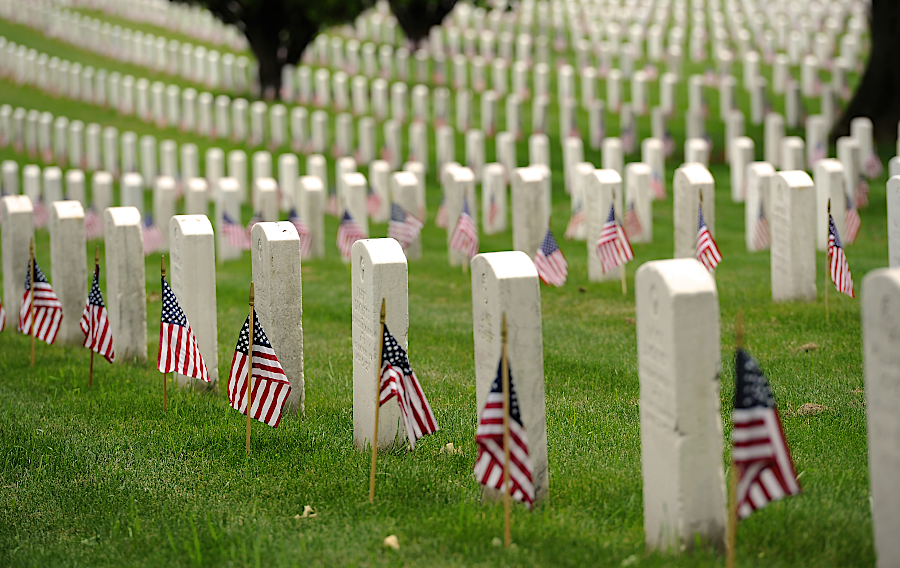
Arlington National Cemetery is the most prestigious burial site in Virginia
Source: US Army, Arlington National Cemetery - 2019 Environmental Assessment for the Southern Expansion and Associated Roadway Realignment

Arlington National Cemetery is the most prestigious burial site in Virginia
Source: US Army, Arlington National Cemetery - 2019 Environmental Assessment for the Southern Expansion and Associated Roadway Realignment
Graves are "special places" where people bury their dead with ceremony and ritual. Modern religions offer different ways to interpret death, and whether a body should be buried or cremated. Many Virginia farmsteads and plantations had family graveyards rather than large central community cemeteries, and on Tangier Island people are still buried in the yards of their houses.
The beliefs of the original Native American inhabitants are poorly understood, but the valuable "grave goods" left at prehistoric burials makes clear that graves had significance as far back as the Archaic Period.
The oldest burial found to date in the Western Hemisphere was discovered in 2001 in the Quintana Roo cenotes of Yucatan. The human whose skeleton was found has been named Eva of Naharon. She was 20-25 years old when she died and was buried in a dry cave 13,600 years ago. Since then, sea level has risen and her burial site is now underwater.
The oldest grave found to date in North America also dates to the Paleo-Indian period. An infant less than two years old died 12,700 years ago in what today is Montana. The child, labelled today as Anzick-1, was buried with stone stools and red ocher adorning the body. A second burial site, Anzik-2, was found nearby, and it was dated to be 2,000 years later. Two graves in Alaska are from burials 11,500 years ago.
The grave goods at the Anzick-1 site included Clovis points, scrapers, and antlers that had been modified by early hunter-gatherers in North America. An archeologist commented how the Clovis burial indicated beliefs in an afterlife:1
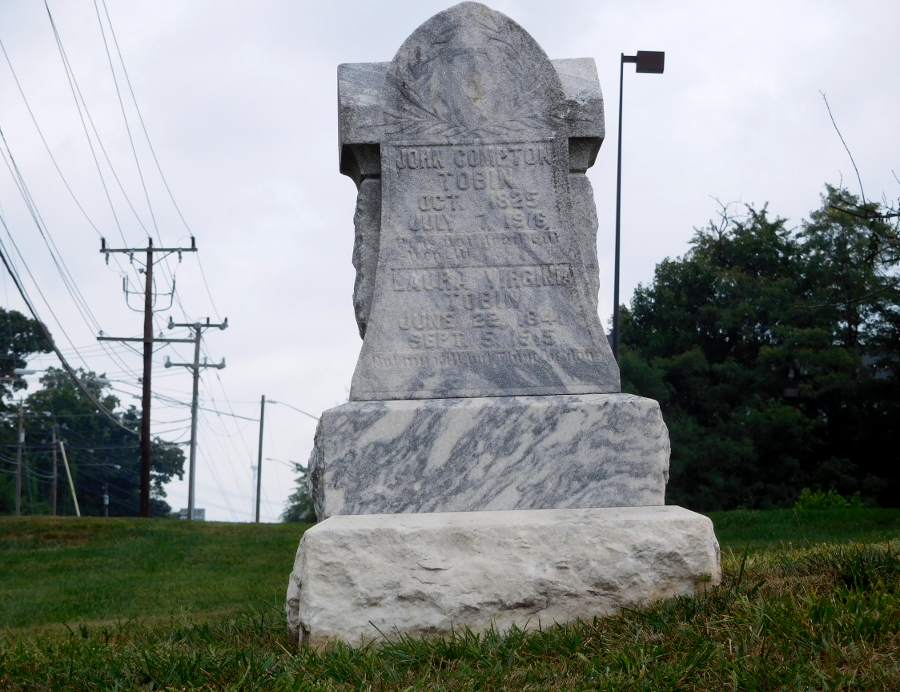
Thompson Family Graveyard (Fairfax County)
On the Coastal Plain from South Carolina to Massachusetts, Native Americans with high status had secondary burials. Bodies were placed on above-ground platforms until the flesh decayed. The major bones were then collected and rolled into leather/skin/grass mats which were placed in ossuaries. Such burials were most common in the time period between 1300-1650CE, but some date back to 1500BCE in Georgia and Florida.
Archeologists have discovered that Native Americans in Virginia buried dogs as well as people. Domesticated dogs were used primarily as hunting aids rather than kept indoors as pets. A few may have achieved special status and been honored by formal burial.
Buried dogs also may have been killed in certain ritual practices, or as trophies indicating warrior success. Excavation of the Hatch Site at Weyanoke Old Town in Prince George County has uncovered a dog cemetery with over 100 burials. Dedicated pet cemeteries were not developed in the United States until 1899, when Hartsdale Pet Cemetery opened north of New York City.2

in secondary burials after 1300CE, the bones of high-status individuals were placed inside ossuaries
Source: British Museum, An ossuary temple (by John White)
The oldest known burial in Virginia which can be associated with a named individual is at Jamestown.
Many of the first colonists at Jamestown were buried secretly in 1607. That was done to hide from Powhatan how rapidly the English were losing strength and the capacity to withstand an attack. Deaths during the "Starving Time" winter of 1609-10 were so numerous that the colonists planned to abandon Jamestown and sail home.
Graves of many of those early colonists have been excavated as part of the Jamestown Rediscovery project. Within the walls of the first church built at Jamestown where the elite leaders were buried, archeologist have excavated the graves of Rev. Robert Hunt (died 1608), Gabriel Archer (died 1609), Sir Ferdinando Wainman (died 1610), and Captain William West (died 1610).
They were just some of the many early colonists who did not survive long at Jamestown. As described by Encyclopedia Virginia:3

most of the colonists who arrived at Jamestown were dead by the end of the 1609-10 winter
Source: Encyclopedia Virginia, The Myth of "Living Off the Land" at Jamestown (painting by Sidney King)
The oldest surviving marked tombstone in North America is the Knights Tombstone at Jamestown. It was thought to mark the burial site of Sir George Yeardley, who died in 1627. Archeology has revealed that the tombstone was in place within the 1617 frame church, the second constructed at the site, before the third brick church was built in 1639.
The tombstone was relocated in the 1640s when the southern entrance of the church was reconstructed. It was rediscovered in 1907, already broken into pieces. They were fitted together and the grave marker was then placed in its current prominent location in the chancel.
Though the tombstone is often described as made from "black marble," it is actually a limestone that was never metamorphosed into marble. The stone was polished, giving it the appearance of marble. Fossils of foraminifera in the stone, which would have been destroyed by heat and pressure if metamorphosis into marble had occurred, show that it came from Belgium. That demonstrates the Virginia colony's trade network in 1627 included imports from England that had originated in other countries.
The tombstone was carved so brass inlays were inserted in the top. They were likely removed in 1676 during Bacon's Rebellion. The church and most other building at Jamestown were burned; the Knights Tombstone probably was desecrated then as well in 1676. After Bacon's Rebellion, Yardley's step-grandson Adam Thorowgood II ordered a similar marble stone for his planned tomb. Thorowgood:4
Archeologists gathered DNA from bones found in the grave located the center of the chancel of the 1617 church; there was enough to conduct genetic testing of the mitochondrial genome passed down through the female line. Research identified 10 descendants of Katherin Yeardley, the sister of Sir George Yeardley. One consented to a DNA test, and it indicated that the bones were not associated with Katherin Yeardley or Sir George Yeardley. It remains a mystery who was buried in such a prominent site.5
Source: Jamestown Rediscovery, Mysterious Knight's Tomb: Oldest Gravestone in America?
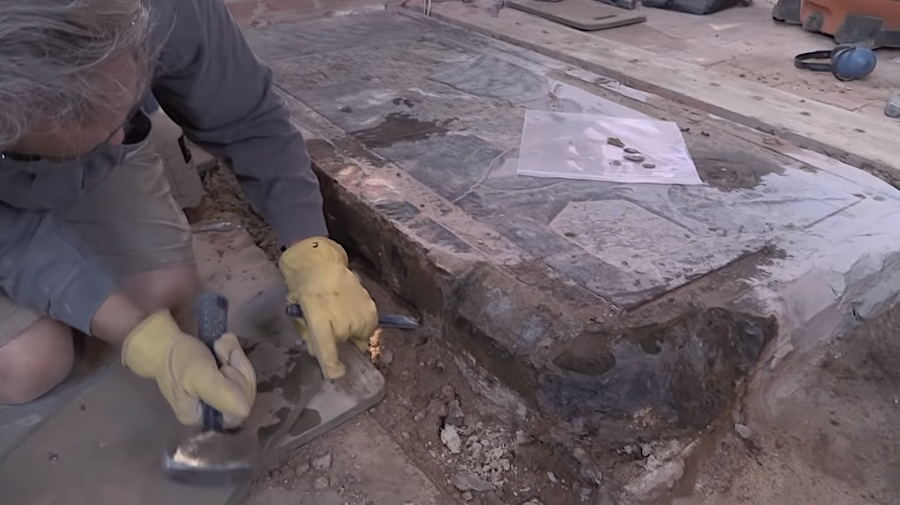
the oldest gravestone in Virginia was removed in 2017 for restoration
Source: Jamestown Rediscovery, Mysterious Knight's Tomb: Oldest Gravestone in America?
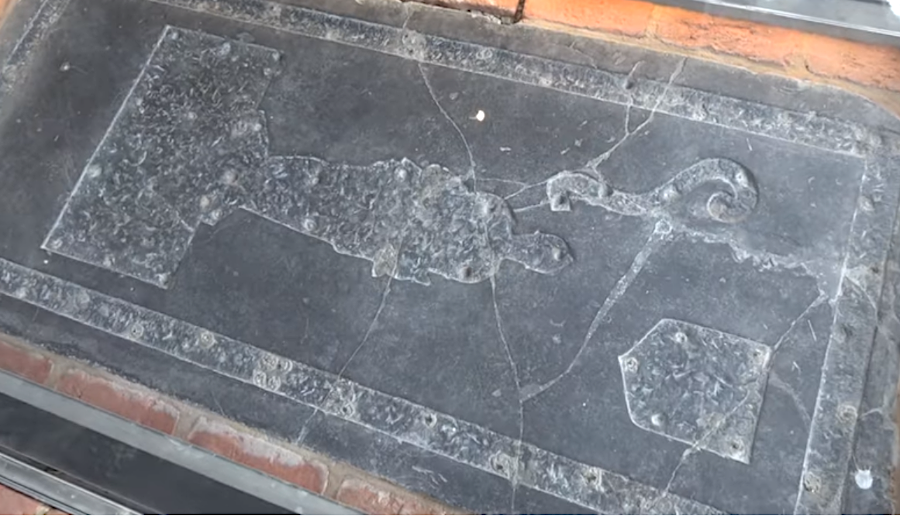
the stone covering the Knight's Tomb, thought to be the 1627 grave of Sir George Yeardley, was replaced in 2019
Source: Jamestown Rediscovery, Knight's tombstone returns to Jamestown's church
There may be earlier graves of Europeans in Virginia, but no such graves prior to 1607 have been identified yet. It is possible that bodies of sailors who were buried at sea later washed ashore, and Native Americans may have examined the corpses and then placed bones in the ground. Eight Spanish Jesuits were executed at Ajacan (near modern-day Yorktown) in 1571, but there is no oral history to indicate if they were left to decay on the surface or if someone later collected and buried their bones.
Some sailors who died while on ships exploring the coastline and Chesapeake Bay in the 1500's could be buried on a Virginia beach. Swimmers going into the water may be walking on top of such graves, due to sea level rise over the last 500 years.
Graveyards that were expected to be everlasting resting places are affected by later land use changes. In some cases, especially for gravesites of slaves, local memories of the graveyards have disappeared and construction has disturbed the sites.
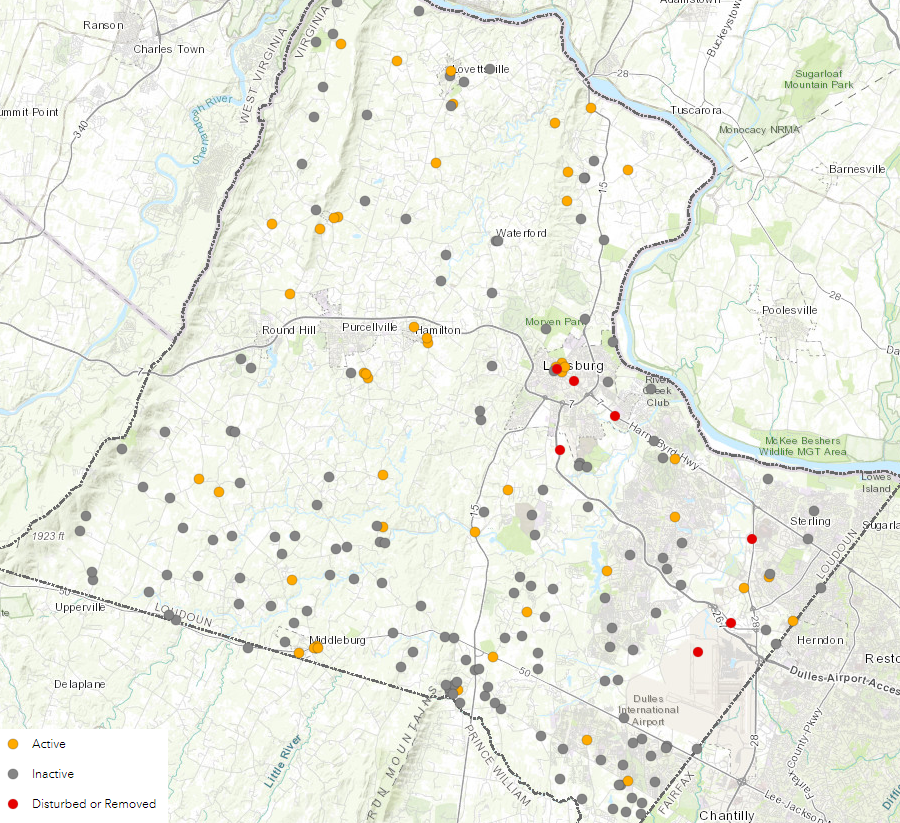
to prevent unplanned disturbance of graveyards, especially poorly-documented sites associated with African-American communities, Loudoun County mapped all of its historic burial grounds
Source: Loudoun County, Loudoun County Cemeteries and Burial Grounds
At the University of Virginia, the graveyard established in 1828 became the burial ground of professors and Confederate soldiers who died in the hospital there during the Civil War. A monument to those soldiers was erected in 1898, with the inscription "Fate denied them victory but crowned them with glorious immortality."
Also buried in that graveyard, but outside the stone walls, were the enslaved people who worked at the university. Some were hired from nearby landowners, and others were owned by the University of Virginia itself. Thomas Jefferson had prohibited students from bringing their personal slaves to the "grounds" of the university, but the institution relied upon slavery to provide a labor force at low cost.
The graves of the enslaved were not marked with tombstones, and for over a century they were ignored. Their presence was rediscovered only when the university planned to expand the graveyard beyond the stone walls.6
Graveyards are "homes of ancestors." Especially in rural areas and small towns, they are deeply associated with community identity. Graveyards at the first churches in an area mark the original places where colonists first settled.

Prince William Forest Park includes 26 old graveyards
Source: National Park Service, Archeology in the Prince William Forest Park
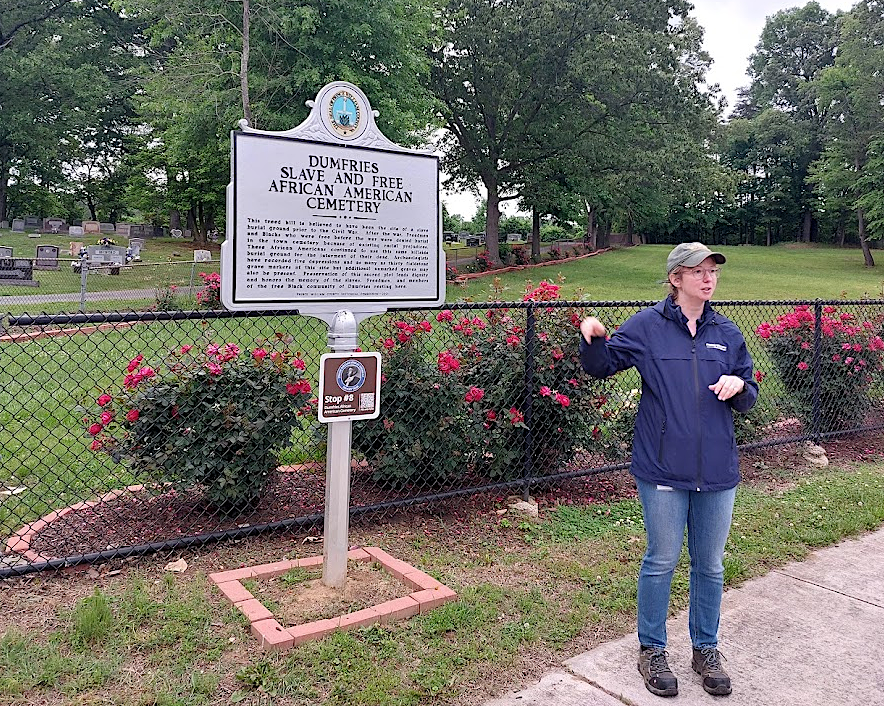
Prince William County residents can tour the different cemeteries at Dumfries established in the 1700's for whites and for free/enslaved blacks - but no Native American burial sites have been identified in the county
There are over 9,000 burial sites recorded in the Virginia Department of Historic Resources' Virginia Cultural Resource Information System (V-CRIS). The archeology component of the database documents all Native American graves discovered at archeological sites, together with other burial sites that lack above-ground markers with writing.
At the end of 2020, there were 2,446 "funerary" sites in that part of the database. The architectural side of the Virginia Cultural Resource Information System documented the locations of 6,561 cemeteries and burial grounds with above-ground markers that contain written information.7
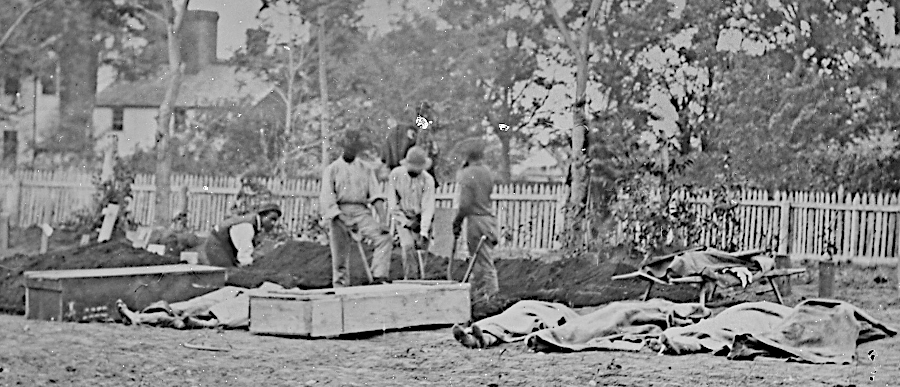
black men burying white Confederate soldiers during the Civil War
Source: National Archives, Burying Confederate dead, Fredericksburg, Va
Disrupting a graveyard is a disruption of a community. Local opposition to the construction of the dam that created Smith Mountain Lake in the 1960's was mitigated by the decision of the Appalachian Power Company to find family cemeteries and move 1,135 graves from the future lake bottom.8
Gravesites are a memorial to the life of a person. The design of the US Capitol includes a gravesite for George Washington, who died in 1799. His will requested that he be interred at Mount Vernon, and Martha Washington rejected proposals to bury him in the building being constructed for the US Congress in the new capital named after Washington.
His body was placed in the family burial vault at his home, In 1831, the bodies of the Washington family members were moved to a new, more-impressive brick tomb built nearby. Mount Vernon advertises now:9
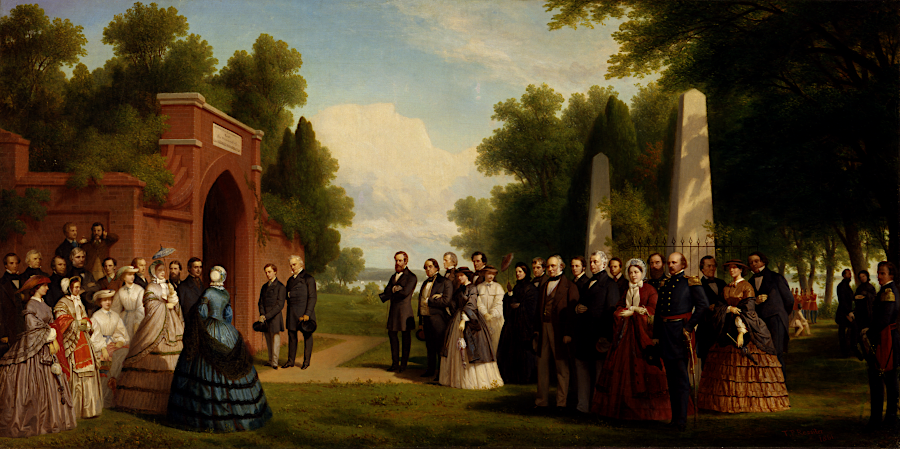
George Washington stayed buried at Mount Vernon, and was not moved to lie underneath the Rotunda in the US Capitol
Source: Smithsonian American Art Museum, Visit of the Prince of Wales, President Buchanan, and Dignitaries to the Tomb of Washington at Mount Vernon, October 1860
Graveyards are significant to more than just the immediate families of those who have been buried at the site. A gravesite in some cemeteries, such as Hollywood Cemetery in Richmond, helps to define a family's social status in a community.
Other graveyards are associated with support for the Union or the Confederacy during the Civil War.
During the Civil War, local farmers communities were overwhelmed by the number of dead left on a battlefield. Soldiers quickly buried most, but often not all, of the bodies before marching on to the next encampment or battle. Later, remains were exhumed and transferred to formal burial sites.

burying a Union soldier near Falmouth, Virginia
Source: Archive.org, Frank Leslie's illustrated history of the Civil War (p.453)
If any sort of temporary headstone had been erected to mark the gravesite, and the words were still readable, the identify of the individual would be marked at the final gravesite. Otherwise, the bones ended up reburied as "unidentified." Sometimes the military unit of the dead soldier would be recognized, based on the understanding of which units had fought at different locations on the battlefield.

a stereoscope image of a burial at Manassas, with temporary grave markers
Source: Manassas National Battlefield Park, Facebook post (February 18, 2025)
President Lincoln's Gettysburg Address was delivered at the dedication of the Soldiers' National Cemetery, in which just Union soldiers were supposed to be buried. The remains of 3,200 Confederate soldiers were shipped south after the end of the Civil War to be interred near their homes, or in memorials to the Confederate cause such as at Hollywood Cemetery.10
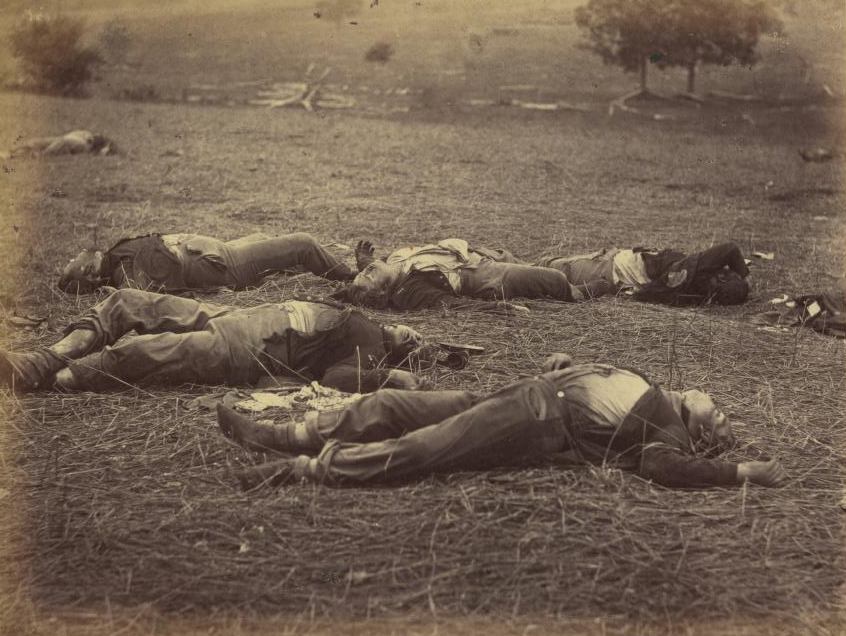
burial details or local residents dug shallow graves after each battle
Source: Alexander Gardner, Gardner's Photographic Sketch Book of the War

the Confederate war dead were honored in 1869 by a 90-foot high monument of local granite in Hollywood Cemetery
Source: Library of Congress, Monument at Richmond erected to Confederate soldiers by the ladies of that place
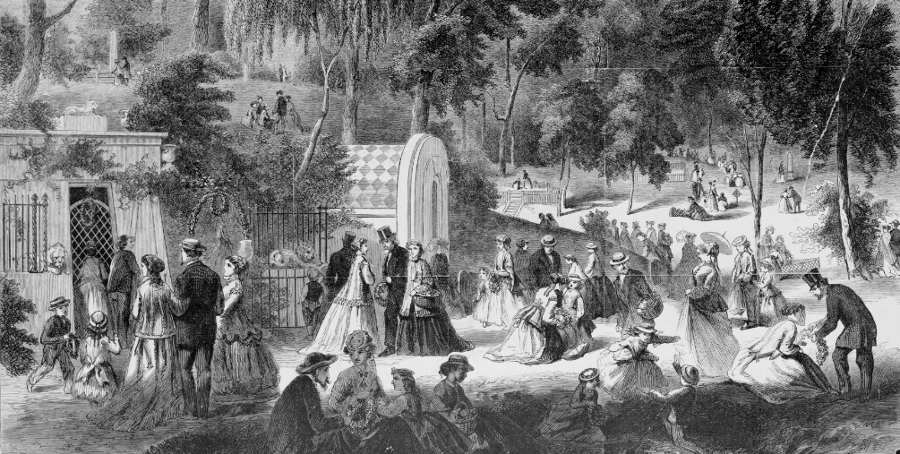
decorating the graves of the Confederate war dead at Hollywood Cemetery became an annual community event for the white community in Richmond
Source: Library of Congress, Hollywood Cemetery, Richmond, Virginia - decorating the graves of the rebel soldiers, May 31, 1867
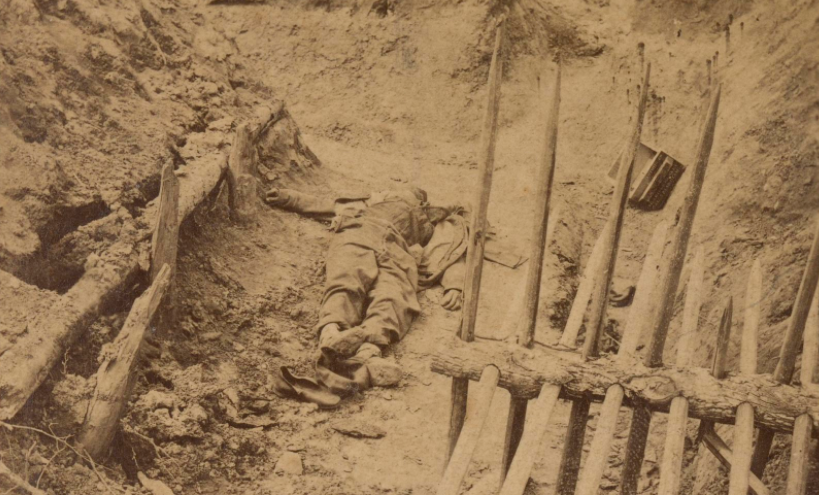
bodies of soldiers killed in the Civil War, such as this Confederate at Fort Mahone, had to be buried
Source: Smithsonian Institution, Stereograph of two deceased Confederate soldiers in a trench
In Alexandria, deaths during the 1860's led to the creation of three graveyards that illustrate social divisions of the time. On the grounds of Christ Church, 34 Confederate prisoners of war were buried. Union soldiers were buried at the Alexandria National Cemetery, while former slaves were interred at a third site which became known as the Freedman's Cemetery.11
The first black soldiers who died at Alexandria were buried in the Freedman's Cemetery, not with the white soldiers at the Alexandria National Cemetery. Other black soldiers objected to the discrimination. The army reacted to their complaints, disinterred the black soldiers, and reburied them at the Alexandria National Cemetery.
The Christ Church and Alexandria National Cemetery graveyards were protected from disturbance. The Freedman's Cemetery was not. It was used for burials just between 1864-1869. Though the site was known in the community, it was not protected. In 1955, a gas station was built on top of the graveyard, and later an office building was constructed there. Building I-95 may have destroyed a portion of the cemetery.
In 2007, after the city public recognized the existence of the Freedman's Cemetery, the gas station and office building were removed and the site re-dedicated as a burial ground. A statue was installed in 2014 to honor the graveyard, 150 years after the first freed slaves were buried there.12
To maintain graves of Confederate veterans in Virginia, starting in the 1930's the General Assembly directed state funding to Confederate memorial associations and chapters of the United Daughters of the Confederacy. The legislature expanded the program in 1997, providing support for over 10,000 graves. Funding was set at $5 or the average actual cost of routine maintenance, whichever was greater, for each grave, monument or marker.
State officials at the time described the program as a public-private partnership, and compared it to the Federal government's support of military cemeteries in which Union soldiers and sailors were buried. The few black legislators did not protest the vote, in part because they were planning to seek funding for maintenance of historic African-American cemeteries in the next General Assembly meeting.
In 1997, the boundary of state support for maintaining graves was clear:13

memorial for Confederate soldiers at the Cedar Hill Cemetery in Suffolk
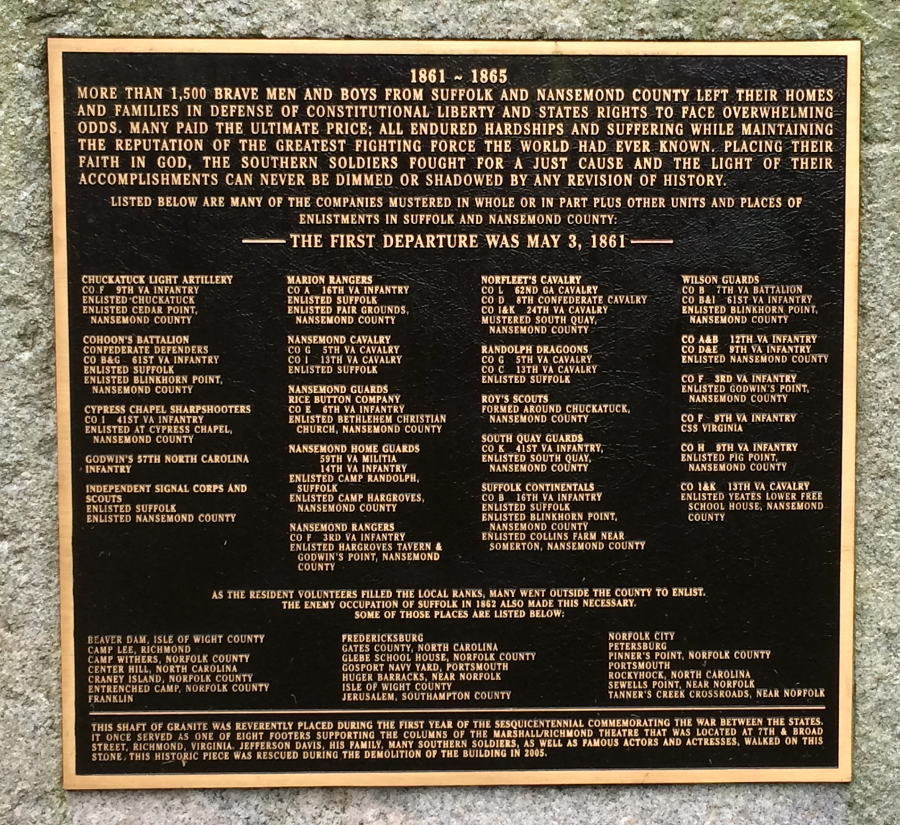
memorial at the Cedar Hill Cemetery in Suffolk claims Confederate soldiers fought for a "just cause"
In 2002, similar legislation authorized funding for the Virginia Society of the Sons of the American Revolution (VASSAR) and Revolutionary War memorial associations to care for graves of Revolutionary War veterans. The Joint Legislative Audit and Review Commission (JLARC) estimated that 65,000 Virginians served during the Revolutionary War. There were 1,481 known burials in Virginia with Revolutionary War veterans. In addition, in Colonial National Historical Park at Yorktown there is an unmarked, common grave with an estimated 50 French soldiers. They are some of the 637 French veterans, now recognized by name at the French Memorial Cemetery, who died in the 1781 Yorktown campaign (including the Battle of the Capes).
Across Virginia there are an estimated 560 cemeteries with one or more graves known to include veterans from the Revolutionary War, with 705 markers that require maintenance. Of the 560 identified cemeteries, only 66 had three or more graves with veterans from that war.
There are many other sites, primarily family graveyards, which the Joint Legislative Audit and Review Commission did not list in its report. A scholar researching one Virginia regiment noted:14
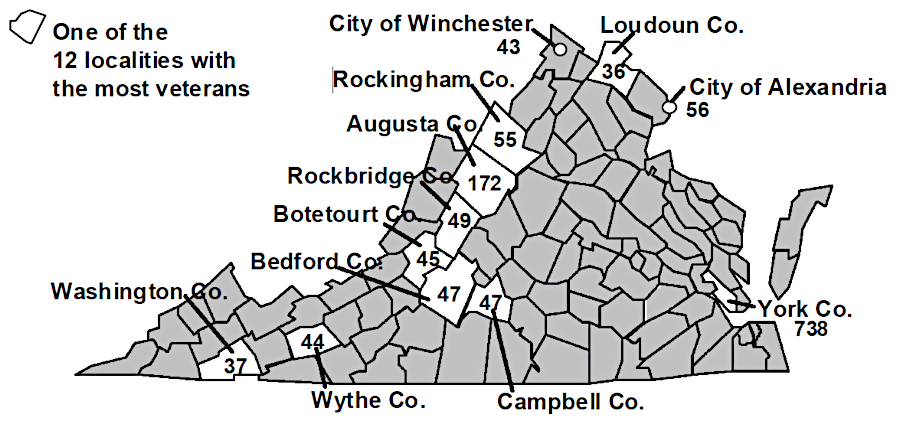
in 2001, the Joint Legislative Audit and Review Commission identified 560 gravesites and 705 markers for Revolutionary War veterans
Source: Joint Legislative Audit and Review Commission, Preservation of Revolutionary War Veteran Gravesites (p.ii)
In 2017, the General Assembly authorized comparable funding for care of graves and cemeteries established prior to January 1, 1900 for the interment of African Americans. Only two cemeteries were authorized initially, East End and Evergreen in Richmond.
Since then, the state legislature has approved funding for care of additional historic African-American cemeteries. The support from the African American Cemetery & Graves Fund is provided to "qualified charitable organizations" for the care of those graves, typically 501(c)(3) non-government organizations or local government agencies.15
In addition to Union and Confederate soldiers, there are British soldiers in Virginia graves from the Revolutionary War, World War I, and World War II.
The commander of British forces in Virginia in 1780, Major General William Phillips, died in Petersburg from disease on on May 13, 1781. He was buried at Blandford Church in an unmarked grave, as directed by his second-in-command Benedict Arnold. In 1914, the local chapter of the National Society of the Daughters of the American Revolution placed a marker in the cemetery commemorating the British General. Phillips is the highest-ranked British officer who is buried in a foreign grave.16
"Hessian" soldiers hired by Great Britain also died in Virginia during the Revolutionary War. About 37,000 soldiers during the war came from the states of Hessen-Kassel, Hesse-Hanau, Brunswick, Waldeck, Brandenburg-Anspach, and Anhals-Zerbst. Some of those who ended up being buried in the United States must be at the sites of prisoner of war camps near Winchester and Charlottesville.
A plan to develop a site in Charlottesville near the Hessian Barracks was interrupted after local residents and the Albemarle Historical Society claimed there was a graveyard on it. Records indicate that 185 graves were dug between January-August 1779. The development ended up being built next to the graveyard, and a plaque shared the local history.
In Hampton Roads, a surveyor marking the boundary between the cities of Suffolk and Chesapeake identified in 1987 what he determined to be a Hessian cemetery with 27 depressions.
World War I soldier British Army Serjeant Major George M. Symons is buried in Petersburg at Poplar Grove National Cemetery. He was training men at Camp Lee when the influenza epidemic struck. Symons died on October 8, 1918, slightly more than a month before the war ended on November 11.
During World War II, 423 men from Great Britain died in the United States while engaged in training. Some are buried in four cemeteries in Hampton Roads - Hampton National Cemetery (Hampton), Evergreen Memorial Park (Portsmouth), Forest Lawn Cemetery (Norfolk)< and Creeds Oak Grove Cemetery (Virginia Beach).
A total of 75 foreign nationals from 13 countries are buried at Arlington National Cemetery. Most died while in the United States on training assignments. One German and two Italian prisoners of war, honorably buried after dying in captivity as required by the terms of the 1929 Geneva Convention. Some burials are comingled remains with Americans who died together in airplanes and helicopters.
At Hampton National Cemetery, 29 sailors from a German submarine were buried on April 15, 1942. The USS Roper sank the U-85 of Cape Hatteras, and all the bodies recovered the following day were buried in Virginia. An additional 55 German and 5 Italian prisoners-of-war who died during World War II are buried in Hampton National Cemetery.17
Perhaps the oddest sermon preached in Virginia occurred *below* a graveyard. A Baptist minister visited the Midlothian coal mines in 1844. Reverend Jacob T. Tinsley was given a tour of the underground workings, and ended up over 1,000 feet underground beneath the old Wooldridge cemetery. A historian later noted:18
The largest single grave in Virginia may be Memorial Hill, at Blandford Cemetery in Petersburg. Remains of a reported 30,000 soldiers were reburied in one mass grave there in 1866. During the siege of Petersburg in 1864-65, the dead had been buried quickly at convenient sites. After the end of the war in 1865, the Ladies Memorial Association of Petersburg arranged for bodies to be exhumed and transferred to a mass grave at Blandford Cemetery.19
The largest cemetery in the United States is the Calvary Cemetery in New York City. Since it opened in 1848 in what is now the Borough of Queens, 3,000,000 people have been buried on the 365 acres there.20
Cemeteries are not guaranteed to be a permanently protected site. State law includes authorization for moving existing graves for construction of roads, buildings, and even quarries.
Until passage of the Native American Graves Protection and Repatriation Act in 1990, archeologists routinely excavated Native American burials and studied the human remains. 23 institutions have reported cultural items, including Native American remains, taken from 41 counties in Virginia.
During residential development at Virginia Beach in the 1970's and 1980's, 64 skeletons thought to be associated with the Chesapeake tribe were excavated in salvage archeology projects. The bones were stockpiled in a warehouse until the nearby Nansemond tribe arranged for their reburial at First Landing State Park:21
In 2025, the Danville-Pittsylvania Regional Industrial Facility Authority spent $1.9 million to buy land next to the 3,528-acre Southern Virginia Megasite at Berry Hill. The Oak Hill property was a part of the historic Hairston plantation, and the industrial authority planned to rebury next to it the remains from 100 unmarked graves in two cemeteries on the megasite. The graves were of former enslaved people and tenant farmers who had been buried between the end of the Civil War and 1950. Transfer of the graves, estimated to cost about $350,000, would allow for full industrial use of Lot 3 at the Berry Hill site while accommodating the concerns of local residents.22
The demand for new cemetery space was impacted by the cultural adoption of cemation. A columbarium storing ashes requires less space than a traditional graveyard. By 2023, 60% of burials were through cremation. That percentage was projected to climb to 80% by 2045.23
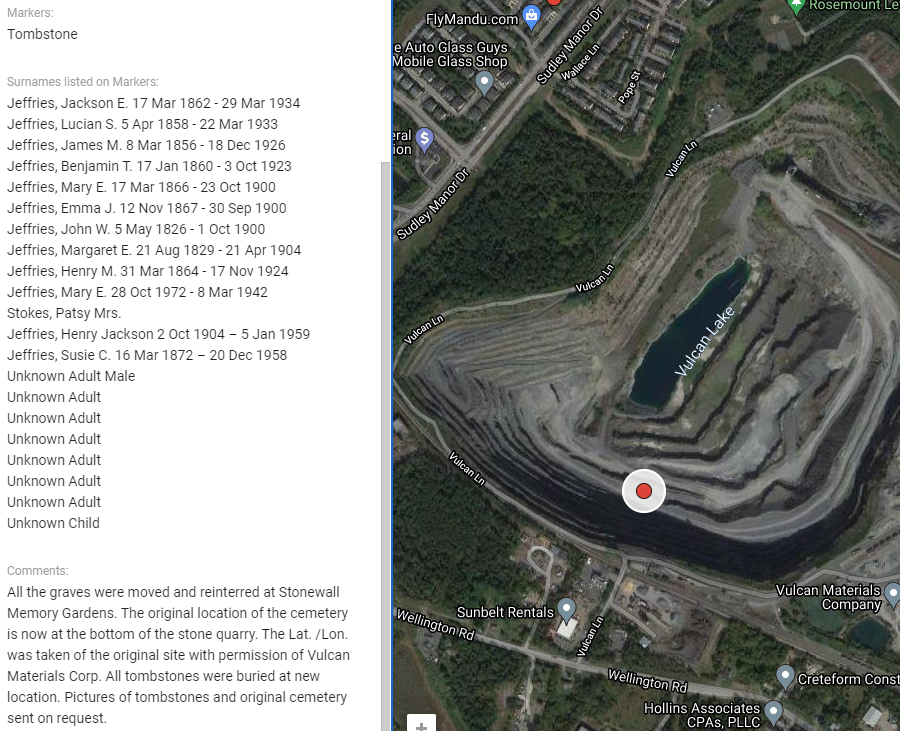
all graves in the Jeffries family cemetery were moved in order to develop the Vulcan quarry in Prince William County near Manassas Mall
Source: Historic Prince William, Prince William County Virginia Cemeteries
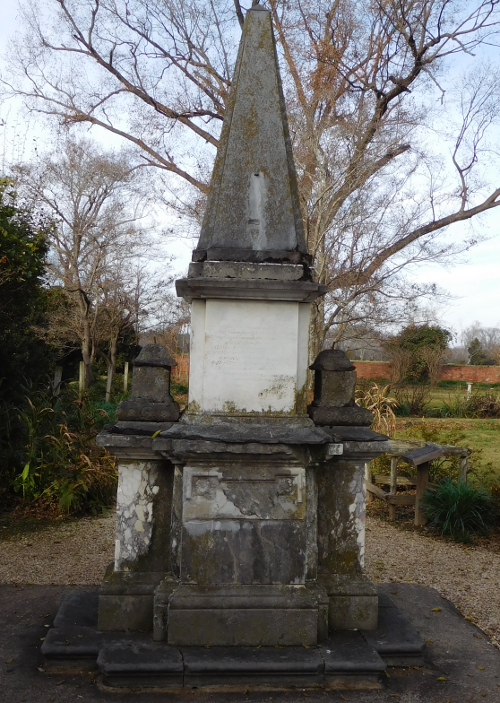
the garden of Westover Plantation, on the banks of the James River in Charles City County, is the special and final resting place for William Byrd II, founder of Richmond

St. John's Episcopal Church in Columbia (Fluvanna County)

Confederate grave at St. John's Episcopal Church in Columbia (Fluvanna County)
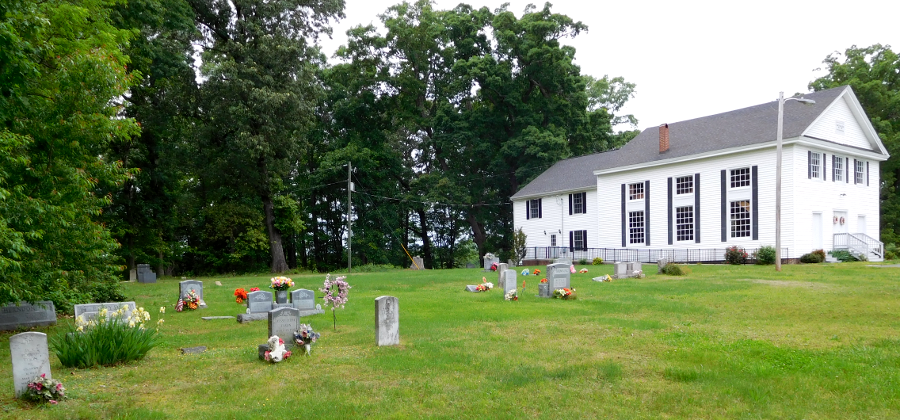
graveyard at Forks of Willis Church (Cumberland County)
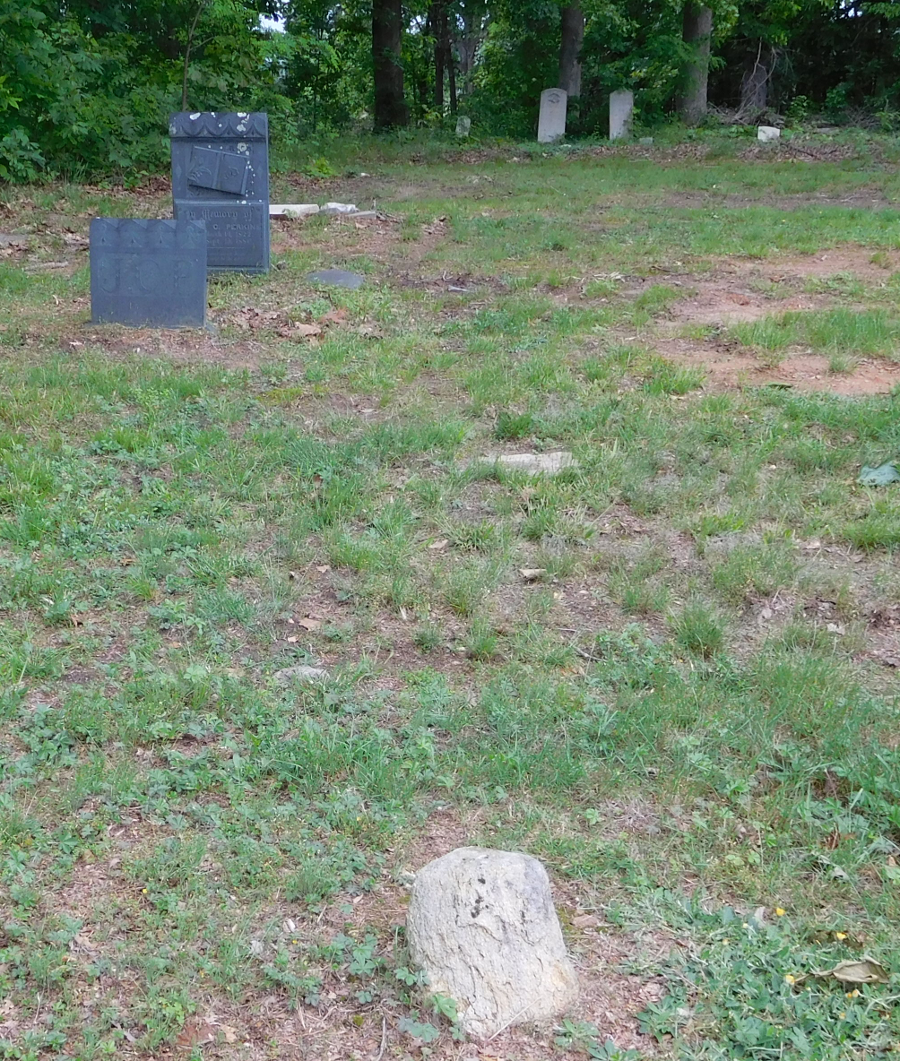
gravestones at Forks of Willis Church include fieldstone and slate

periwinkle grows at the base of a gravestone at Forks of Willis Church
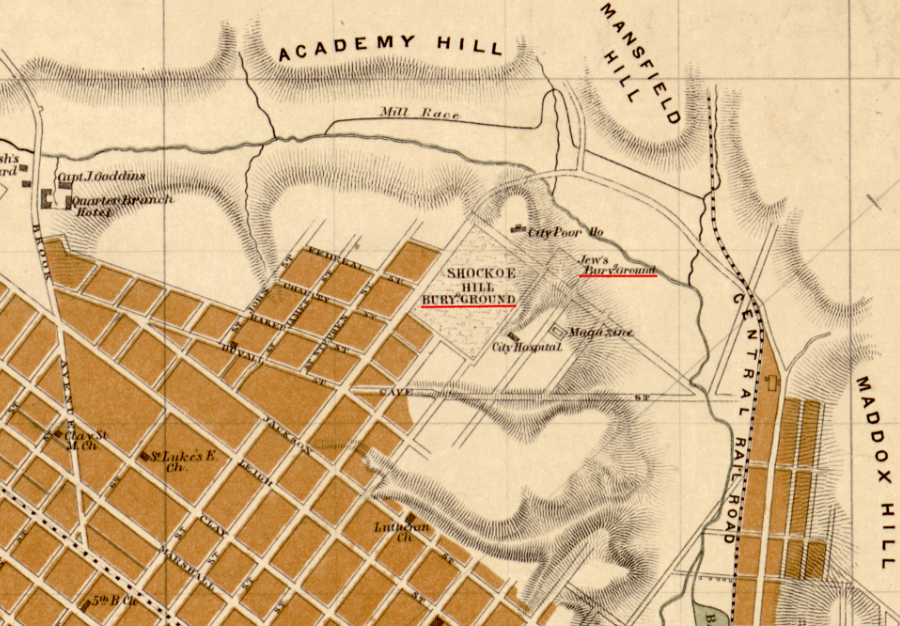
in the mid-1800's, Richmond had graveyards on its northern edge, as well as Hollywood Cemetery on the west, to replace the traditional burying ground at St. John's Church on Church Hill
Source: Library of Congress, Map of the city of Richmond, Virginia
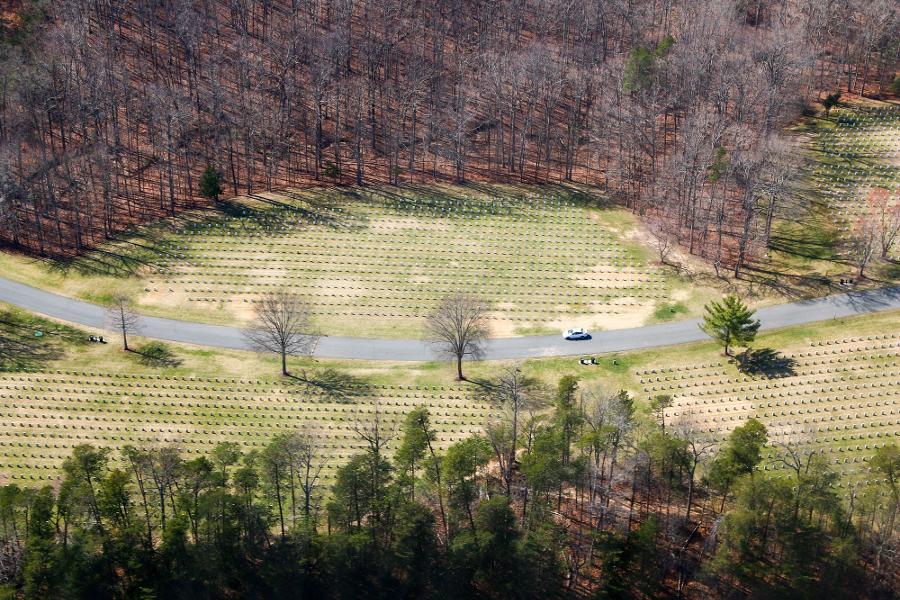
Veterans Administration cemetery at Quantico
Source: Historic Prince William, Quantico National Cemetery - #171

Veterans Administration cemetery at Quantico
Source: Historic Prince William, Quantico National Cemetery - #173

Stonewall Memory Gardens was developed as a cemetery before the National Park Service acquired all the surrounding land for Manassas National Battlefield Park
Source: Historic Prince William, Rt. 29 and Stonewall Memory Gardens - #310
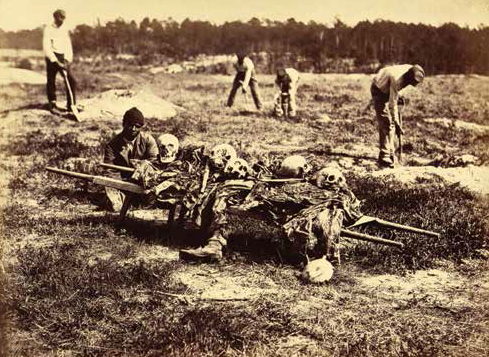
the Federal government moved Union soldiers buried on Virginia battlefields to military cemeteries after the Civil War ended
Source: US Department of Veterans Affairs, Federal Stewardship Of Confederate Dead (p.15)

in 1939, the Great Depression led to price reductions even on tombstones in Lexington, Virginia
Source: Library of Congress, Bargain tombstones. Lexington, Virginia
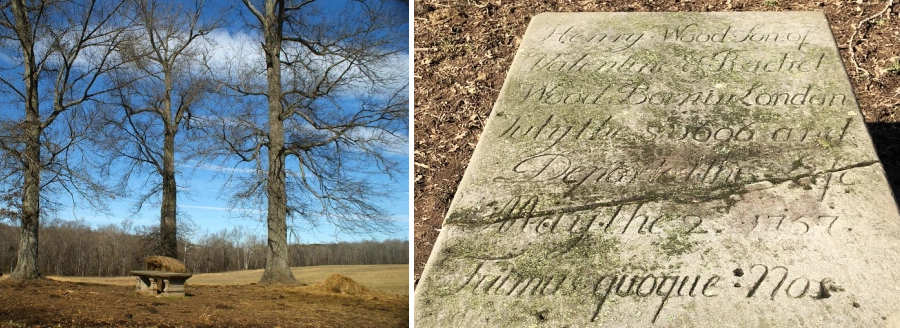
the tomb of Henry Wood, first Clerk of the Court in Goochland County, is on an isolated hilltop
Source: Goochland History, Henry Wood's Tomb
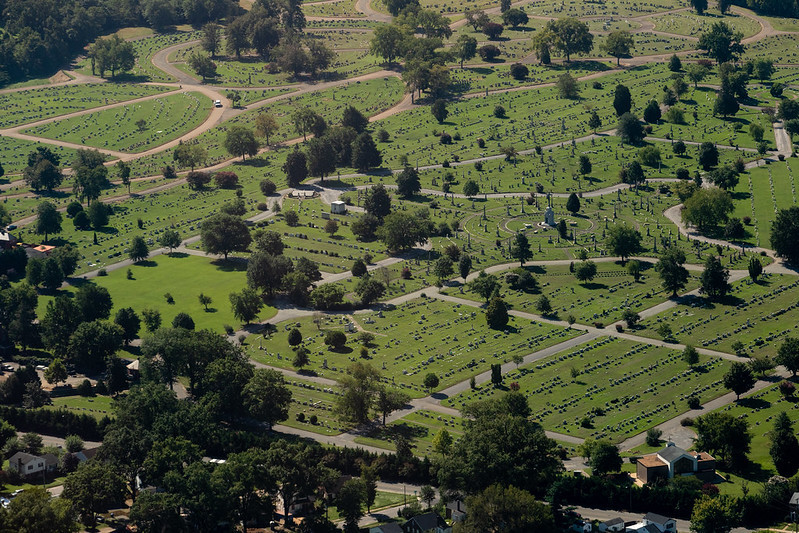
Riverview Cemetery in Richmond (2018)
Source: Chesapeake Bay Program, Riverview Cemetery
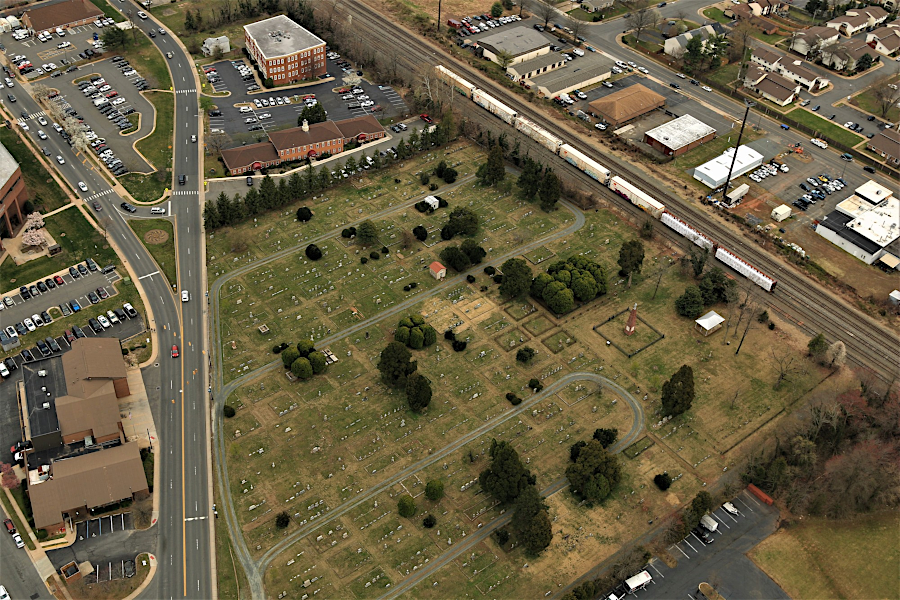
Manassas Cemetery (2019)
Source: Historic Prince William, Aerial Photo Survey 2019
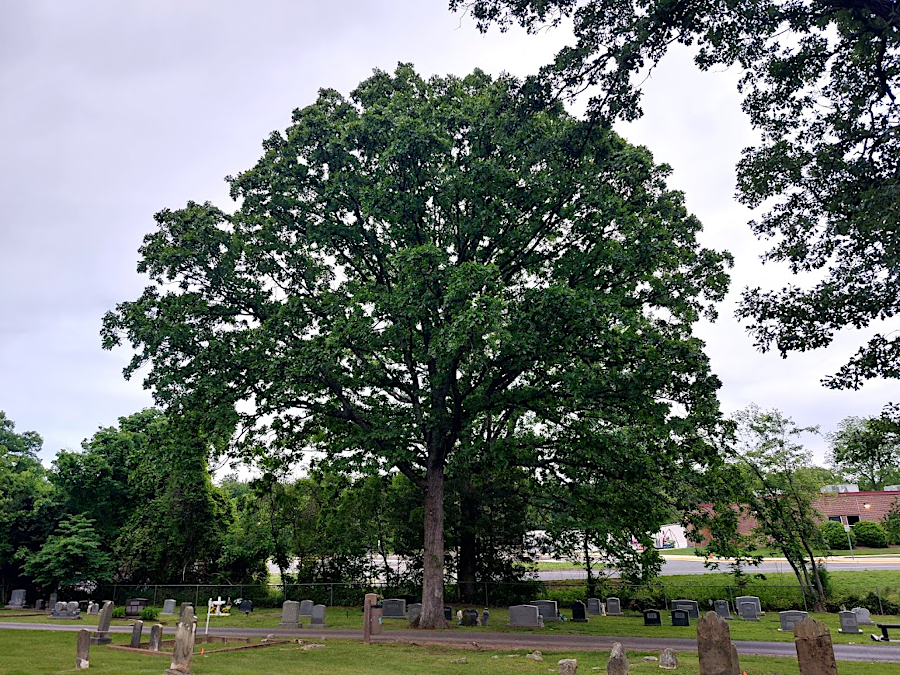
because cemeteries are open spaces, the few trees allowed to grow receive enough sunlight to maintain branches all the way to the ground (Dumfries Cemetery, Prince William County)
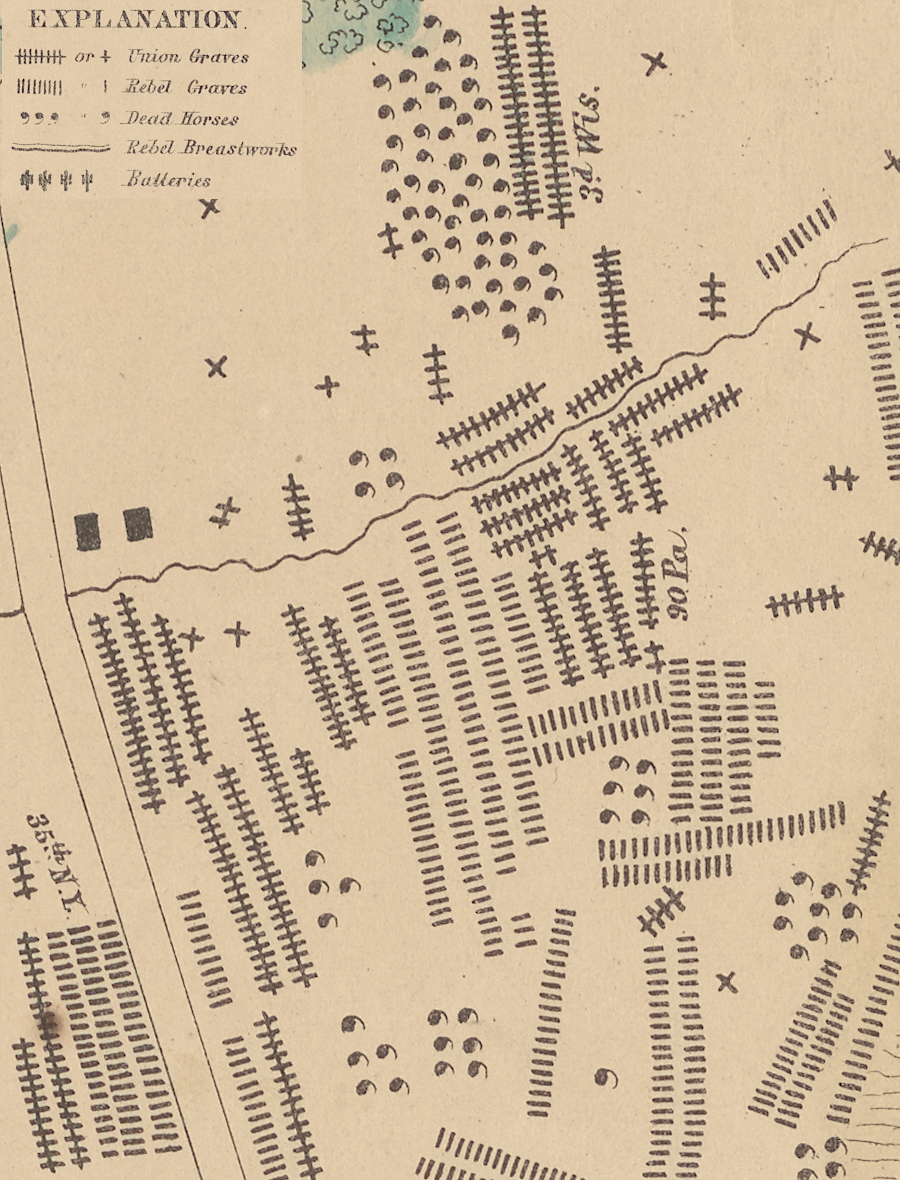
soldiers (and horses...) were buried in temporary graves at Antietam, and later the bodies of soldiers were moved to permanent cemeteries
Source: New York Public Library, Map of the battlefield of Antietam (by Simon G. Elliott, 1864)

at the Dawson cemetery in Bull Run Mountain Natural Area Preserve, the Virginia Outdoor Foundation has identified many graves without carved headstones
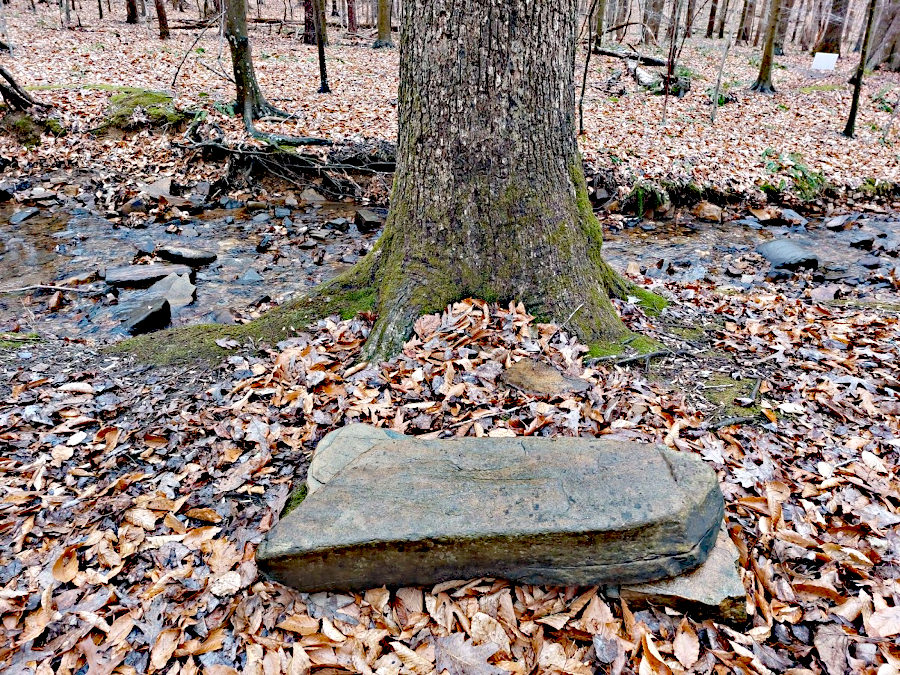
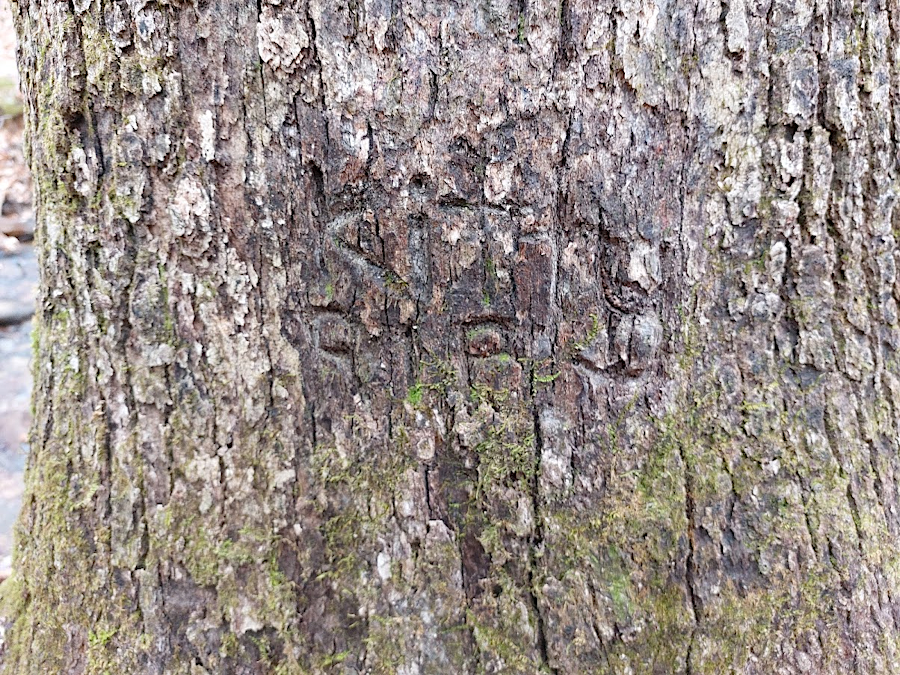
"Kitty RIP" - pet memorials in the woods can be as elaborate as at sites for human burials

everybody may not end up buried in a graveyard, but even the best of makeup only postpones the inevitable last step of ageing
Source: Wikipedia, All Is Vanity (by Charles Allan Gilbert, 1892)